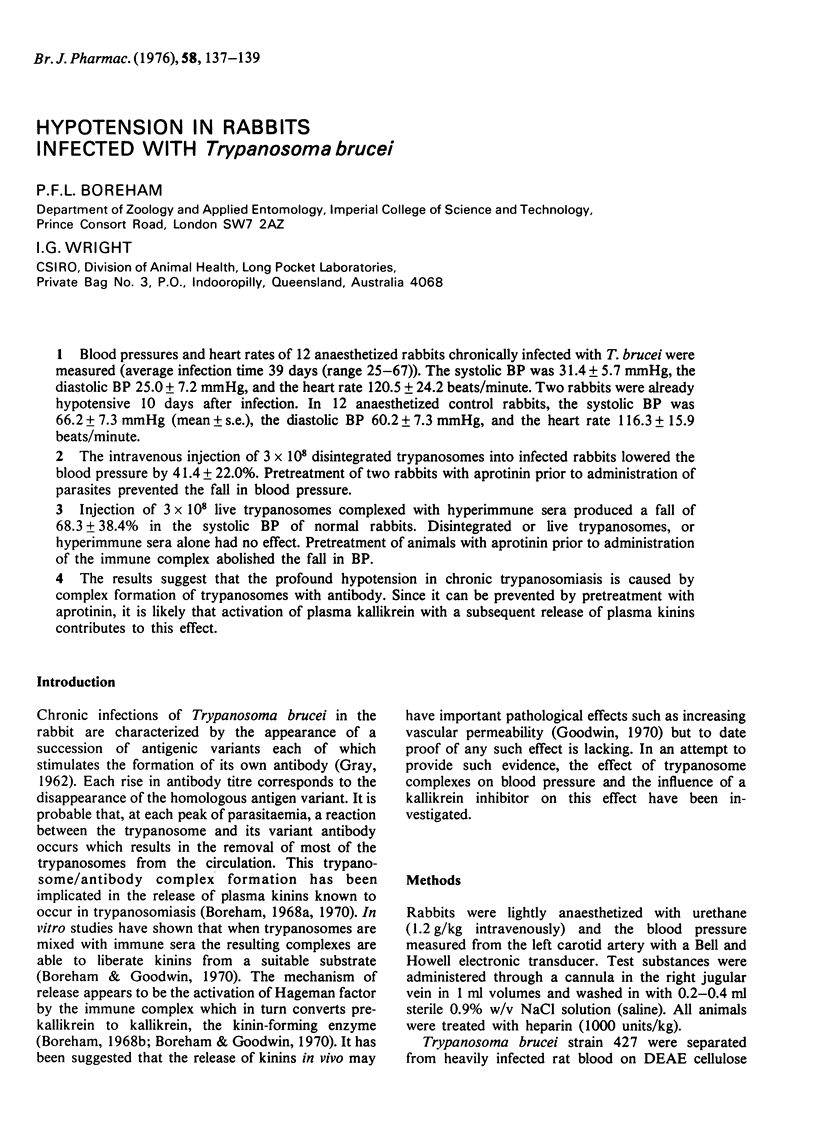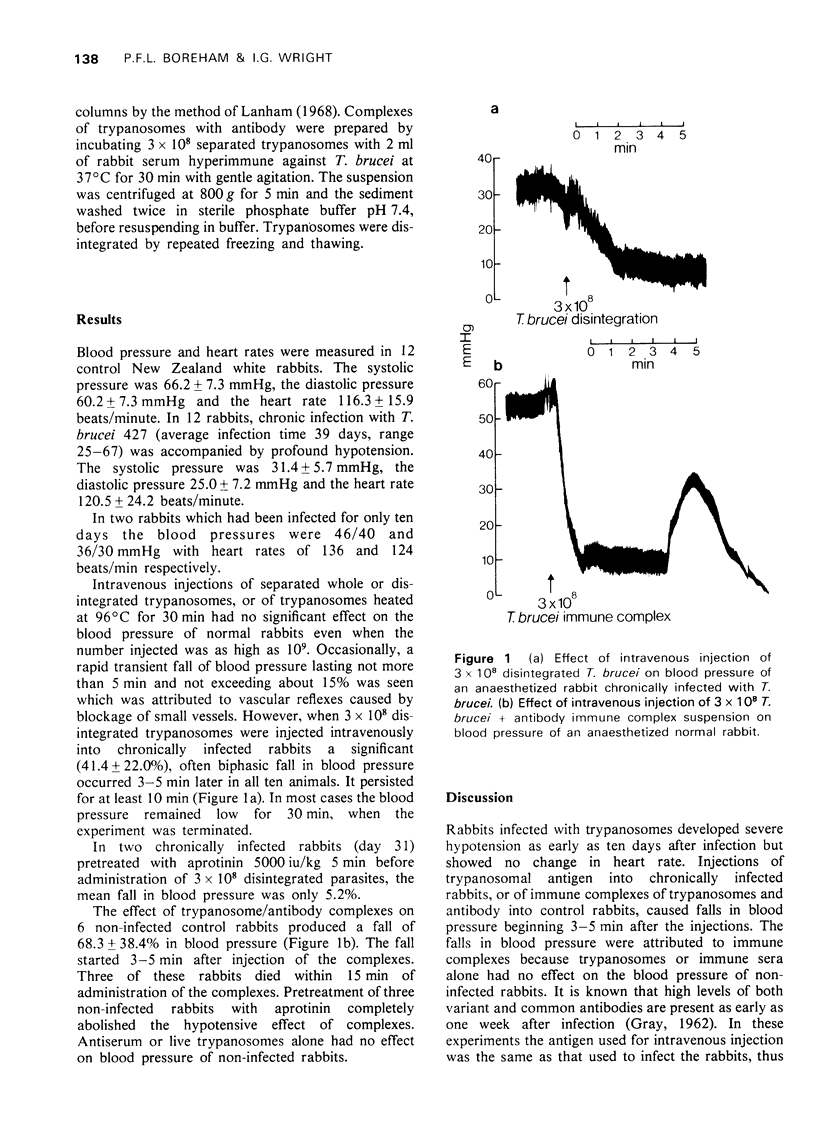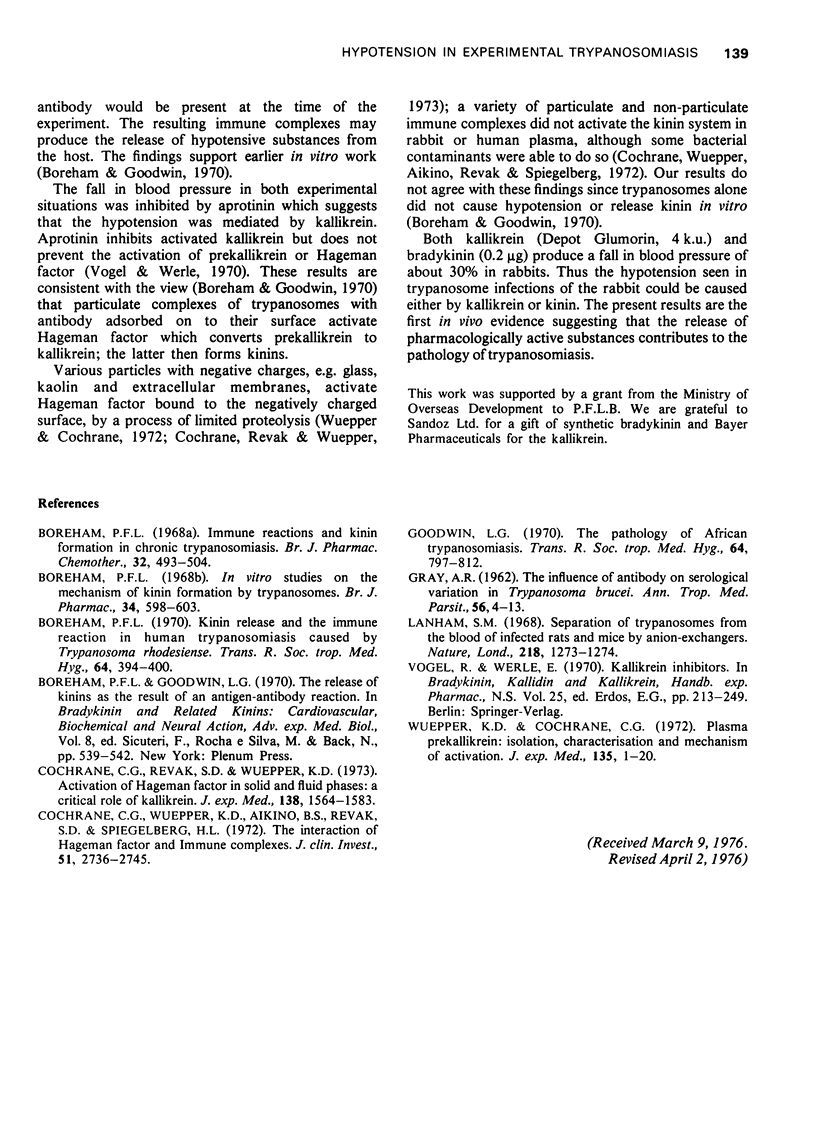Abstract
1 Blood pressures and heart rates of 12 anaesthetized rabbits chronically infected with T.brucei were measured (average infection time 39 days (range 25-67). The systolic BP was 31.4 +/- 5.7 mmHg, the diastolic BP 25.0 +/- 7.2 mmHg, and the heart rate 120.5 +/- 24.2 beats/minute. Two rabbits were already hypotensive 10 days after infection. In 12 anaesthetized control rabbits, the systolic BP was 66.2 +/- 7.3 mmHg (mean +/- s.e.), the diastolic BP 60.2 +/- 7.3 mmHg, and the heart rate 116.3 +/- 15.9 beats/minute. 2 The intravenous injection of 3 X 10(8) disintegrated trypanosomes into infected rabbits lowered the blood pressure by 41.4 +/- 22.0%. Pretreatment of two rabbits with aprotinin prior to administration of parasites prevented the fall in blood pressure. 3 Injection of 3 X 10(8) live trypanosomes complexed with hyperimmune sera produced a fall of 68.3 +/- 38.4% in the systolic BP of normal rabbits. Disintegrated or live trypanosomes, or hyperimmune sera alone had no effect. Pretreatment of animals with aprotinin prior to administration of the immune complex abolished the fall in BP. 4 The results suggest that the profound hypotension in chronic trypanosomiasis is caused by complex formation of trypanosomes with antibody. Since it can be prevented by pretreatment with aprotinin, it is likely that activation of plasma kallikrein with a subsequent release of plasma kinins contributes to this effect.
Full text
PDF


Selected References
These references are in PubMed. This may not be the complete list of references from this article.
- Boreham P. F. Immune reactions and kinin formation in chronic trypanosomiasis. Br J Pharmacol Chemother. 1968 Mar;32(3):493–504. doi: 10.1111/j.1476-5381.1968.tb00450.x. [DOI] [PMC free article] [PubMed] [Google Scholar]
- Boreham P. F. In vitro studies on the mechanism of kinin formation by trypanosomes. Br J Pharmacol. 1968 Nov;34(3):598–603. doi: 10.1111/j.1476-5381.1968.tb08488.x. [DOI] [PMC free article] [PubMed] [Google Scholar]
- Boreham P. F. Kinin release and the immune reaction in human trypanosomiasis caused by Trypanosoma rhodesiense. Trans R Soc Trop Med Hyg. 1970;64(3):394–400. doi: 10.1016/0035-9203(70)90175-6. [DOI] [PubMed] [Google Scholar]
- Cochrane C. G., Revak S. D., Wuepper K. D. Activation of Hageman factor in solid and fluid phases. A critical role of kallikrein. J Exp Med. 1973 Dec 1;138(6):1564–1583. doi: 10.1084/jem.138.6.1564. [DOI] [PMC free article] [PubMed] [Google Scholar]
- Cochrane C. G., Wuepper K. D., Aiken B. S., Revak S. D., Spiegelberg H. L. The interaction of Hageman factor and immune complexes. J Clin Invest. 1972 Oct;51(10):2736–2745. doi: 10.1172/JCI107093. [DOI] [PMC free article] [PubMed] [Google Scholar]
- GRAY A. R. The influence of antibody on serological variation in Trypanosoma brucei. Ann Trop Med Parasitol. 1962 Apr;56:4–13. doi: 10.1080/00034983.1962.11686083. [DOI] [PubMed] [Google Scholar]
- Goodwin L. G. The pathology of African trypanosomiasis. Trans R Soc Trop Med Hyg. 1970;64(6):797–817. doi: 10.1016/0035-9203(70)90096-9. [DOI] [PubMed] [Google Scholar]
- Lanham S. M. Separation of trypanosomes from the blood of infected rats and mice by anion-exchangers. Nature. 1968 Jun 29;218(5148):1273–1274. doi: 10.1038/2181273a0. [DOI] [PubMed] [Google Scholar]
- Wuepper K. D., Cochrane C. G. Plasma prekallikrein: isolation, characterization, and mechanism of activation. J Exp Med. 1972 Jan;135(1):1–20. doi: 10.1084/jem.135.1.1. [DOI] [PMC free article] [PubMed] [Google Scholar]


